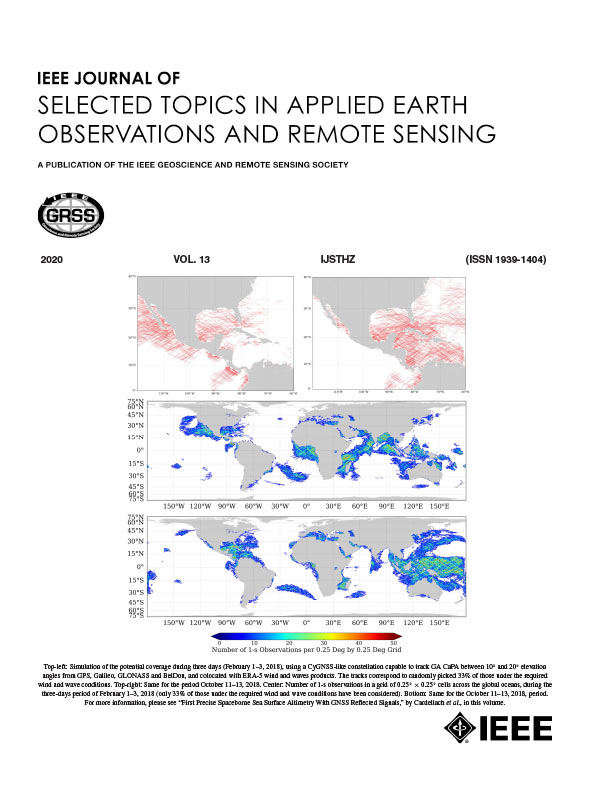PPLM-Net: Partial Patch Local Masking Net for Remote Sensing Image Unsupervised Domain Adaptation Classification
IF 4.7
2区 地球科学
Q1 ENGINEERING, ELECTRICAL & ELECTRONIC
IEEE Journal of Selected Topics in Applied Earth Observations and Remote Sensing
Pub Date : 2024-09-06
DOI:10.1109/JSTARS.2024.3455438
引用次数: 0
Abstract
In remote sensing image classification task, it is often apply a model trained on one dataset (source domain) to another dataset (target domain). However, due to the presence of domain shift between these domains where data are not independent and identically distributed, the performance of the model typically deteriorates. Domain adaptation aims to improve the generalization performance of the model in the target domain. In response to the challenges of intricate backgrounds, domain shift, and potentially unlabeled target domain in remote sensing images, this article proposes a network specifically designed for unsupervised domain adaptation (UDA) classification of remote sensing images, named PPLM-net. The network consists of a domain adversarial training (DAT) module, a partial patch local masking (PPLM) module and a teacher–student network module. The DAT module enables the network to extract domain-invariant features. The PPLM module compels the model to focus on the global information of target domain remote sensing images with intricate backgrounds, learning contextual content to improve model performance. The teacher network generates pseudolabels for complete unlabeled target domain images. The student network trained with PPLM target domain classification loss to generate robust and discriminative features. We construct a dataset dedicated to the UDA scene classification task of remote sensing images named RSDA. We collect images from four publicly available datasets spanning seven common categories, containing over 10 000 images. Compared with the current state-of-the-art UDA model, PPLM-net achieves the best results in 12 domain adaptation classification tasks on RSDA. The average accuracy reaches 99.115%.PPLM-net:用于遥感图像无监督域自适应分类的局部补丁局部掩蔽网
在遥感图像分类任务中,通常会将在一个数据集(源域)上训练的模型应用到另一个数据集(目标域)上。然而,由于这些域之间存在数据不独立且分布不完全相同的域偏移,模型的性能通常会下降。域适应旨在提高模型在目标域中的泛化性能。为了应对遥感图像中错综复杂的背景、域偏移和潜在的未标记目标域等挑战,本文提出了一种专门用于遥感图像无监督域适应(UDA)分类的网络,命名为 PPLM-网络。该网络由一个域对抗训练(DAT)模块、一个局部补丁局部掩蔽(PPLM)模块和一个师生网络模块组成。DAT 模块使网络能够提取与领域无关的特征。PPLM 模块迫使模型关注具有复杂背景的目标域遥感图像的全局信息,学习上下文内容以提高模型性能。教师网络为完整的无标签目标域图像生成伪标签。学生网络使用 PPLM 目标域分类损失进行训练,以生成稳健的判别特征。我们构建了一个专门用于遥感图像 UDA 场景分类任务的数据集,命名为 RSDA。我们从四个公开可用的数据集中收集了跨越七个常见类别的图像,共包含 10,000 多张图像。与当前最先进的 UDA 模型相比,PPLM-net 在 RSDA 的 12 个领域适应性分类任务中取得了最佳结果。平均准确率达到 99.115%。
本文章由计算机程序翻译,如有差异,请以英文原文为准。
求助全文
约1分钟内获得全文
求助全文
来源期刊
CiteScore
9.30
自引率
10.90%
发文量
563
审稿时长
4.7 months
期刊介绍:
The IEEE Journal of Selected Topics in Applied Earth Observations and Remote Sensing addresses the growing field of applications in Earth observations and remote sensing, and also provides a venue for the rapidly expanding special issues that are being sponsored by the IEEE Geosciences and Remote Sensing Society. The journal draws upon the experience of the highly successful “IEEE Transactions on Geoscience and Remote Sensing” and provide a complementary medium for the wide range of topics in applied earth observations. The ‘Applications’ areas encompasses the societal benefit areas of the Global Earth Observations Systems of Systems (GEOSS) program. Through deliberations over two years, ministers from 50 countries agreed to identify nine areas where Earth observation could positively impact the quality of life and health of their respective countries. Some of these are areas not traditionally addressed in the IEEE context. These include biodiversity, health and climate. Yet it is the skill sets of IEEE members, in areas such as observations, communications, computers, signal processing, standards and ocean engineering, that form the technical underpinnings of GEOSS. Thus, the Journal attracts a broad range of interests that serves both present members in new ways and expands the IEEE visibility into new areas.

 求助内容:
求助内容: 应助结果提醒方式:
应助结果提醒方式:


